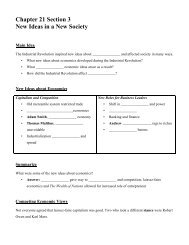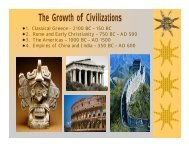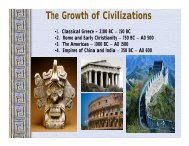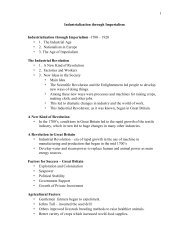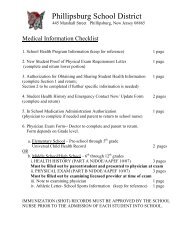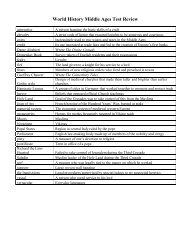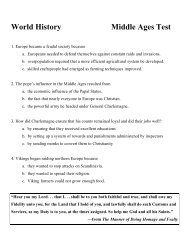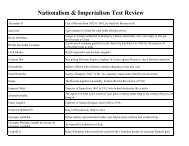Gross Domestic Product and Growth Outline
Gross Domestic Product and Growth Outline
Gross Domestic Product and Growth Outline
You also want an ePaper? Increase the reach of your titles
YUMPU automatically turns print PDFs into web optimized ePapers that Google loves.
Name _________________________ Class _______________ Date _______________<br />
CHAPTER<br />
12<br />
CHAPTER OUTLINE<br />
<strong>Gross</strong> <strong>Domestic</strong> <strong>Product</strong> <strong>and</strong> <strong>Growth</strong> 2<br />
Directions: Fill in the outline below. Filling in the blanks will help<br />
you as you read <strong>and</strong> study Chapter 12.<br />
I. Section 1: <strong>Gross</strong> <strong>Domestic</strong> <strong>Product</strong><br />
A. Defining <strong>Gross</strong> <strong>Domestic</strong> <strong>Product</strong><br />
1. <strong>Gross</strong> domestic product (GDP) is the<br />
of all final goods <strong>and</strong> services produced in a country in a given year.<br />
2. <strong>Gross</strong> domestic product may be calculated using the<br />
approach or the<br />
approach.<br />
3. Nominal GDP is measured in prices. Real GDP is<br />
measured in<br />
prices.<br />
B. Limitations of GDP<br />
1. GDP does not include goods <strong>and</strong> services or<br />
business for which there is no record.<br />
2. GDP does not measure people’s health <strong>and</strong> .<br />
C. Factors That Make GDP Go Up or Down<br />
1. The two main factors that affect GDP are supply<br />
<strong>and</strong><br />
dem<strong>and</strong>.<br />
2. As the price level rises, real GDP . As the price<br />
level falls, real GDP .<br />
D. Other Measures of Output <strong>and</strong> Income<br />
1. GDP is used to determine gross product,<br />
national product, national ,<br />
income, <strong>and</strong><br />
personal income.<br />
Copyright © by Pearson Education, Inc., or its affiliates. All rights reserved.<br />
10
Name _________________________ Class _______________ Date _______________<br />
CHAPTER OUTLINE (continued)<br />
<strong>Gross</strong> <strong>Domestic</strong> <strong>Product</strong> <strong>and</strong> <strong>Growth</strong> 2<br />
II. Section 2: Business Cycles<br />
A. Stages of the Business Cycle<br />
1. The four stages of the business cycle are expansion, _________________,<br />
_________________, <strong>and</strong> trough.<br />
2. _________________, _________________, <strong>and</strong> _________________ are<br />
three kinds of contractions.<br />
B. Factors That Drive the Business Cycle<br />
1. The four main factors that keep the business cycle going are business<br />
_________________, interest rates <strong>and</strong> _________________, consumer<br />
_________________, <strong>and</strong> _________________ shocks.<br />
2. Leading _________________ are variables that help economists predict<br />
business cycles.<br />
III. Section 3: Economic <strong>Growth</strong><br />
A. Measuring Economic <strong>Growth</strong><br />
1. Real GDP per capita is real GDP divided by _________________.<br />
2. The basic measure of economic growth is the percentage of change in<br />
_________________ _________________ over a period of time.<br />
B. Capital Deepening<br />
1. Capital deepening is the process of _________________ the amount of<br />
capital per _________________.<br />
2. Saving, _________________, <strong>and</strong> _________________ all affect capital<br />
deepening <strong>and</strong> economic growth.<br />
Copyright © by Pearson Education, Inc., or its affiliates. All rights reserved.<br />
11




